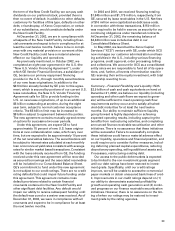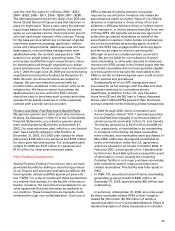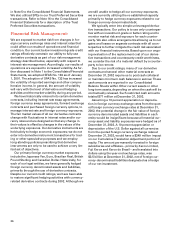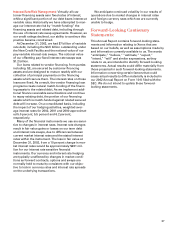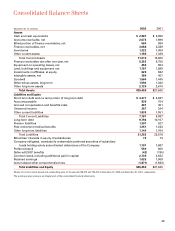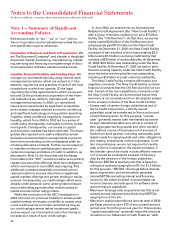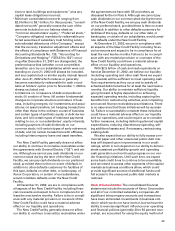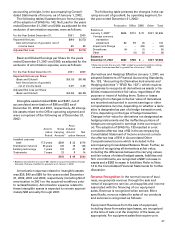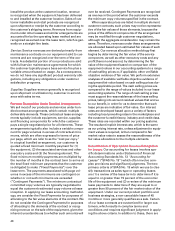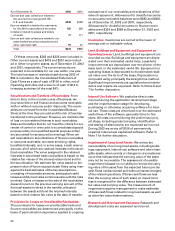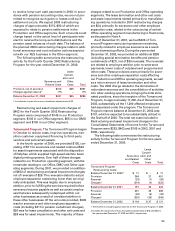Xerox 2002 Annual Report Download - page 45
Download and view the complete annual report
Please find page 45 of the 2002 Xerox annual report below. You can navigate through the pages in the report by either clicking on the pages listed below, or by using the keyword search tool below to find specific information within the annual report.
43
tions to land, buildings and equipment,” plus any
capital lease obligations incurred;
• Minimum consolidated net worth ranging from
$2.9 billion to $3.1 billion; for this purpose, “consoli-
dated net worth” generally means the sum of the
amounts included on our balance sheet as
“Common shareholders’ equity,” “Preferred stock,”
“Company-obligated, mandatorily redeemable pre-
ferred securities of subsidiary trust holding solely
subordinated debentures of the Company,” except
that the currency translation adjustment effects and
the effects of compliance with Statement of Financial
Accounting Standards No. 133, “Accounting for
Derivatives and Hedging” (“SFAS No.133”) occur-
ring after December 31, 2001 are disregarded, the
preferred securities (whether or not convertible)
issued by us or by our subsidiaries which were out-
standing on June 21, 2002 will always be included,
and any capital stock or similar equity interest issued
after June 21, 2002 which matures or generally
becomes mandatorily redeemable for cash or put-
table at holders’ option prior to November 1, 2005 is
always excluded; and
• Limitations on: (i) issuance of debt and preferred
stock; (ii) creation of liens; (iii) certain fundamental
changes to corporate structure and nature of busi-
ness, including mergers; (iv) investments and acqui-
sitions; (v) asset transfers; (vi) hedging transactions
other than those in the ordinary course of business
and certain types of synthetic equity or debt deriva-
tives, and (vii) certain types of restricted payments
relating to our, or our subsidiaries’, equity interests,
including payment of cash dividends on our
common stock; (viii) certain types of early retirement
of debt, and (ix) certain transactions with affiliates,
including intercompany loans and asset transfers.
The New Credit Facility generally does not affect
our ability to continue to monetize receivables under
the agreements with General Electric (“GE”) and oth-
ers. Although we cannot pay cash dividends on our
common stock during the term of the New Credit
Facility, we can pay cash dividends on our preferred
stock, provided there is then no event of default. In
addition to other defaults customary for facilities of
this type, defaults on other debt, or bankruptcy, of
Xerox Corporation, or certain of our subsidiaries,
would constitute defaults under the New Credit
Facility.
At December 31, 2002, we are in compliance with
all aspects of the New Credit Facility including finan-
cial covenants and expect to be in compliance for at
least the next twelve months. Failure to be in compli-
ance with any material provision or covenant of the
New Credit Facility could have a material adverse
effect on our liquidity and operations.
The New Credit Facility generally does not affect
our ability to continue to securitize receivables under
the agreements we have with GE and others, as
discussed further in Note 5. Although we cannot pay
cash dividends on our common stock during the term
of the New Credit Facility, we can pay cash dividends
on our preferred stock, provided there is then no event
of default. In addition to other defaults customary for
facilities of this type, defaults on our other debt, or
bankruptcy, or certain of our subsidiaries, would consti-
tute defaults under the New Credit Facility.
At December 31, 2002, we are in compliance with
all aspects of the New Credit Facility including finan-
cial covenants and expect to be in compliance for at
least the next twelve months. Failure to be in compli-
ance with any material provision or covenant of the
New Credit Facility could have a material adverse
effect on our liquidity and operations.
With $2.9 billion of cash and cash equivalents on
hand at December 31, 2002, we believe our liquidity
(including operating and other cash flows we expect
to generate) will be sufficient to meet operating cash
flow requirements as they occur and to satisfy all
scheduled debt maturities for at least the next twelve
months. Our ability to maintain sufficient liquidity
going forward is highly dependent on achieving
expected operating results, including capturing the
benefits from restructuring activities, and completing
announced finance receivables securitizations. There
is no assurance that these initiatives will be success-
ful. Failure to successfully complete these initiatives
could have a material adverse effect on our liquidity
and our operations, and could require us to consider
further measures, including deferring planned capital
expenditures, reducing discretionary spending, sell-
ing additional assets and, if necessary, restructuring
existing debt.
We also expect that our ability to fully access com-
mercial paper and other unsecured public debt mar-
kets will depend upon improvements in our credit
ratings, which in turn depend on our ability to demon-
strate sustained profitability growth and operating
cash generation and continued progress on our ven-
dor financing initiatives. Until such time, we expect
some bank credit lines to continue to be unavailable,
and we intend to access other segments of the capital
markets as business conditions allow, which could
provide significant sources of additional funds until
full access to the unsecured public debt markets is
restored.
Basis of Consolidation: The consolidated financial
statements include the accounts of Xerox Corporation
and all of our controlled subsidiary companies. All
significant intercompany accounts and transactions
have been eliminated. Investments in business enti-
ties in which we do not have control, but we have the
ability to exercise significant influence over operating
and financial policies (generally 20 to 50 percent own-
ership), are accounted for using the equity method of


